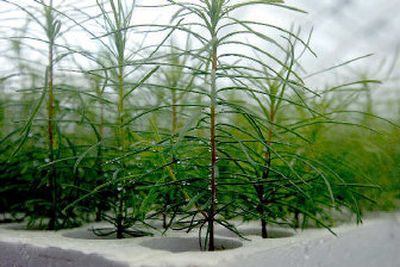Nursery possible site for veterans cemetery

The federal government owns a red-hot piece of property within Coeur d’Alene city limits that Realtors salivate over, and now it’s being eyed as a potential site for a veterans cemetery.
“We get at least one call a month, asking about buying the land,” says Idaho Panhandle National Forests’ information team leader, Dave O’Brien.
“Developers would sure like to get their hands on it.”
And, according to Richard Cesler, director of the Idaho State Veterans Cemetery in Boise, it would also make an ideal last resting place for men and women who have served our country in uniform.
That’s because the soil that underlies the Coeur d’Alene Forest Nursery is relatively free of boulders and other glacially deposited debris, unlike other potential cemetery sites Cesler has considered. Those include a U.S. Forest Service tract near Twin Lakes and a portion of Farragut State Park.
To transfer the nursery grounds into private or state ownership, however, would require the new owner to pay the federal government fair market value for the property plus improvements.
Based on the value of the land itself and the Forest Service’s investments on the 240-acre parcel, it’s worth $30 to $40 million, according to Nursery Superintendent Joe Myers.
Myers explains that 220 of those acres are inside the nursery’s 6-foot perimeter fence.
“When the nursery was founded in 1960, a county road ran through it,” Myers explains. “That was bad for security, so when Kathleen Avenue was built in the early 1970s, we pulled in the fence on the north side. In that area, Kathleen is actually built on federally owned land.”
According to the superintendent, the site includes 15 warehouse-type buildings that are used for tree and seed cold storage. About 15 acres are covered by greenhouses that have heating and cooling systems to protect the nursery stock.
The nursery infrastructure also includes two dwellings and six wells for irrigation, domestic water and to supply the greenhouses.
Last year, the Forest Service upgraded the cold storage machinery to the tune of some $3 million, Myers says. He says that will result in energy savings of $50,000 to $70,000 each year.
The land underlying the nursery is “very well-drained sandy loam,” says Myers. “It’s perfect for growing trees. Our climate is also great for what we do, and it’s predictable.
“The soil can freeze as early as Oct. 15, but usually that occurs about Nov. 15, and our thaws come on March 15, plus or minus 15 days.”
Myers, 53, whose job classification is horticulturalist, began his professional career at the Coeur d’Alene nursery in June 1978 and has worked up through the ranks to his current position.
He earned a bachelor’s in forest management from Northern Arizona University and a master’s in forest science from Colorado State.
His work force consists of 28 permanent employees, about half of whom are employed only seasonally, from March through November.
Myers manages a budget that this year amounts to $3.2 million, about 60 percent of which, he says, is paid to his regular work force and the 40 to 50 contract employees who work at the nursery during the packing and shipping season.
The Coeur d’Alene Forest Nursery produces some 5.5 million trees each year, half of which are grown in greenhouses, and the balance in the ground. They’re used to reforest areas that have been subject to fires or logged.
About 35 acres are devoted to growing grass that’s used to replace exotic plants in national forests and to mitigate damage to forest soils.
Most of the plant material is distributed to national and state forests in the Dakotas, Montana and Idaho, but some also is sent to Washington, Oregon, Utah, Wyoming and Colorado.
“The land that’s not currently being used to produce trees or grass is resting, just like a farmer rests his soil after harvest,” Myers says.
The Coeur d’Alene nursery is one of only six in the national forest system. Others are at Lucky Peak near Boise; Placerville, Calif.; Medford, Ore.; Halsey, Neb.; and Watersmeet, Mich.
“If there’s a higher use for the land and the Congress or administration tells us to go, we’ll be happy to move,” Myers says. “But it would be tough finding a better place to do what we do.”